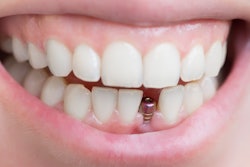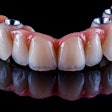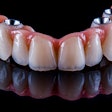
Early implant failure may be linked to smoking, shorter implants, and tapered implant designs in the rehabilitation and restoration of oral function in patients with some tooth loss. The story was published on May 23 in the Journal of Prosthetic Dentistry
Conversely, factors like implant insertion torque, the healing method, adjacent teeth, and diabetes may not significantly affect the risk of early implant failure, according to the study.
"This study provided information that might help dental surgeons properly manage risk factors for early implant failure, such as smoking, implant design (tapered implant), and implant length (implant length <10 mm)," wrote the authors, led by Zhe-Zhen Lin of the Wenzhou Medical University First Affiliated Hospital in China.
The study included 2,061 patients ranging from ages 18 to 91. The cohort comprised 1,005 men and 1,056 women. Inclusion criteria required patients to have received a single crown, a fixed prosthesis, or a removable prosthesis and undergone a healing period of three to six months. Additionally, patients had to have a controlled systemic disease; patient details, such as their age, sex, and smoking habits were recorded; and participants needed to have smoked fewer than 20 cigarettes per day.
Between 2009 and 2022, patients received a total of 3,247 implants. Among them, 875 patients had a single implant and 1,186 had multiple implants. In total, 2,611 implants were placed in the posterior region and 636 in the anterior region. The study observed 99 early implant failures.
A significant link was found between early implant failure and smoking habits (odds ratios [OR] = 1.92; 95% confidence interval [CI], 1.18 to 3.12; p = 0.008). However, early failure was not significantly affected by age (p = 0.130) or diabetes (p = 0.396).
Furthermore, regarding surgical factors, five showed no significant impact on early implant failure: location (p = 0.142), the type of adjacent tooth (p = 0.222), endodontic therapy (p = 0.832), insertion torque (OR = 0.85, p = 0.469), and distance between the implant and adjacent teeth (p = 0.206), they wrote.
Implant design, specifically tapered implants, significantly affected early failure (p = 0.004 univariate; p = 0.007 multivariate; OR = 1.84; 95% CI, 1.19 to 2.84). During the healing period, 25 narrow-diameter implants were mobile, showing a lower survival rate than regular and wide-diameter implants (p = .021 univariate).
However, multivariate analysis showed no significant difference, they wrote.
The study had limitations, including its retrospective design, which made it hard to control individual variables. Future research should involve a larger prospective study to better investigate the factors linked to early implant failure, they added.
"Within the limitation of sample size, smokers, implant length (<10 mm), and implant design (tapered implant) exhibited higher risk of early implant failure in this retrospective study," Lin et al wrote.




















